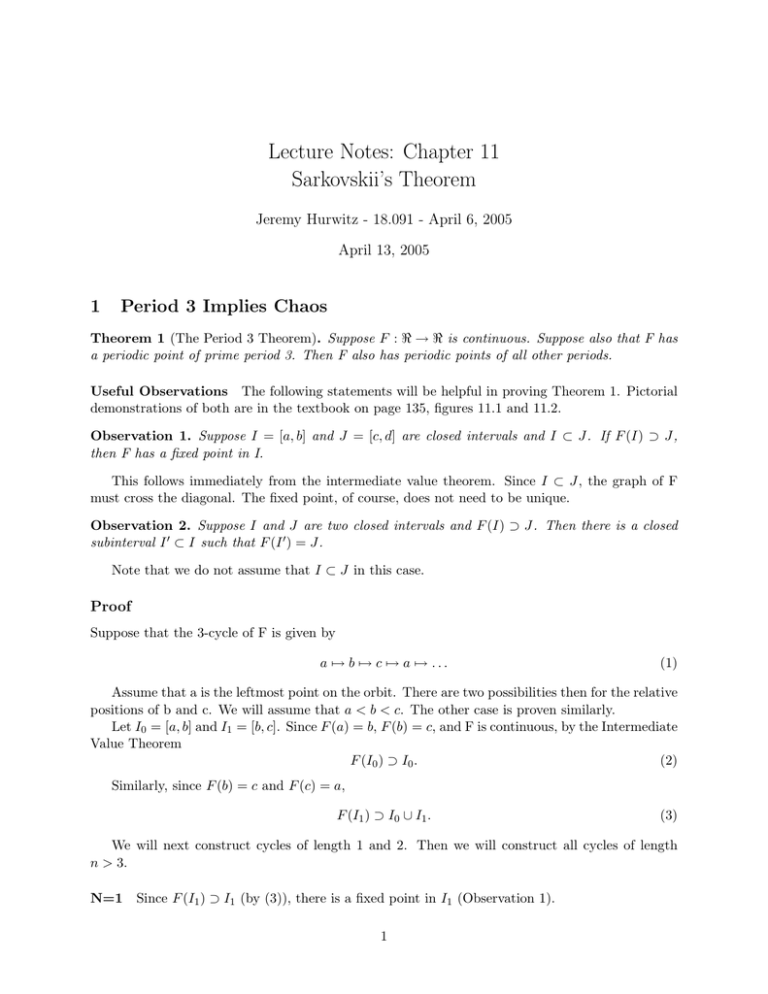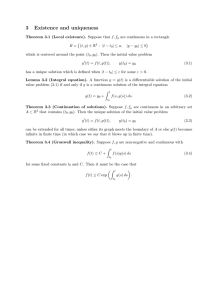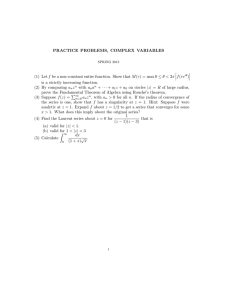Lecture Notes: Chapter 11 Sarkovskii’s Theorem 1
advertisement

Lecture Notes: Chapter 11
Sarkovskii’s Theorem
Jeremy Hurwitz ­ 18.091 ­ April 6, 2005
April 13, 2005
1
Period 3 Implies Chaos
Theorem 1 (The Period 3 Theorem). Suppose F : � → � is continuous. Suppose also that F has
a periodic point of prime period 3. Then F also has periodic points of all other periods.
Useful Observations The following statements will be helpful in proving Theorem 1. Pictorial
demonstrations of both are in the textbook on page 135, figures 11.1 and 11.2.
Observation 1. Suppose I = [a, b] and J = [c, d] are closed intervals and I ⊂ J. If F (I) ⊃ J,
then F has a fixed point in I.
This follows immediately from the intermediate value theorem. Since I ⊂ J, the graph of F
must cross the diagonal. The fixed point, of course, does not need to be unique.
Observation 2. Suppose I and J are two closed intervals and F (I) ⊃ J. Then there is a closed
subinterval I � ⊂ I such that F (I � ) = J.
Note that we do not assume that I ⊂ J in this case.
Proof
Suppose that the 3­cycle of F is given by
a �→ b �→ c �→ a �→ . . .
(1)
Assume that a is the leftmost point on the orbit. There are two possibilities then for the relative
positions of b and c. We will assume that a < b < c. The other case is proven similarly.
Let I0 = [a, b] and I1 = [b, c]. Since F (a) = b, F (b) = c, and F is continuous, by the Intermediate
Value Theorem
F (I0 ) ⊃ I0 .
(2)
Similarly, since F (b) = c and F (c) = a,
F (I1 ) ⊃ I0 ∪ I1 .
(3)
We will next construct cycles of length 1 and 2. Then we will construct all cycles of length
n > 3.
N=1
Since F (I1 ) ⊃ I1 (by (3)), there is a fixed point in I1 (Observation 1).
1
N=2 Since F (I0 ) ⊃ I1 (by (2)) and F (I1 ) ⊃ I0 (by (3)), F 2 (I0 ) ⊃ I0 . So there is a fixed point of
F 2 in I0 (Observation 1). So F has a 2­cycle.
Cycles of Length Greater Than 3
To find a periodic point with period n, we will invoke Observation 2 a total of n times.
Since F (I1 ) ⊃ I1 , there is a closed subinterval A1 ⊂ I1 such that F (A1 ) = I1 .
Again invoking Observation 2, since F (A1 ) ⊃ A1 , we can find a closed subinterval A2 ⊂ A1
such that F (A2 ) = A1 . Note that by construction, A2 ⊂ A1 ⊂ I1 .
Repeat this process n − 2 times. We this end up with a collection of closed subintervals
An−2 ⊂ An−3 ⊂ . . . ⊂ A2 ⊂ A1 ⊂ I1
(4)
Note that F n−2 (An−2 ) = I1 and An−2 ⊂ I1 .
Since F (I0 ) ⊃ I1 ⊃ An−2 ), there is a closed subinterval An−1 ⊂ I0 such that F (An−1 ) = An−2 .
Lastly, since F (I1 ) ⊃ I0 ⊃ An−1 , there is a closed subinterval An ⊂ I1 such that F (An ) = An−1 .
We have now constructed a series of closed intervals such that
An �→ An−1 �→ An−2 . . . �→ A2 �→ A1 �→ I1 .
(5)
Since F n (An ) = I1 and An ⊂ I1 , we may invoke Observation 1 to conclude that there is a point,
x0 fixed by F n .
We must now show that the orbit of x0 has prime period n. Note that x0 �∈ I0 ∩ I1 , since
I0 ∩ I1 = {b} and F (b) = c �∈ I0 , whereas F (x0 ) ∈ F (An ⊂ I0 .
F (x0 ) ∈ I0 , but all other iterations lie in I1 . So x0 cannot have period less than n.
This completes the proof.
2
2.1
Sarkovskii’s Theorem
The Sarkovskii Ordering of the Natural Numbers
The following ordering, read from left­to­right, then top­to­bottom, is known as Sarkovskii’s Or­
dering of the Natural Numbers.
3, 5, 7, 9, . . .
2 · 3, 2 · 5, 2 · 7, . . .
22 · 3, 22 · 5, 22 · 7, . . .
23 · 3, 23 · 5, 23 · 7, . . .
..
.
. . . , 2n , . . . , 23 , 22 , 2, 1
2
2.2
Sarkovskii’s Theorem
Theorem 2 (Sarkovskii’s Theorem). Suppose F : � → � is continuous. Suppose that F has a
periodic point of period n and that n precedes k in the Sarkovskii ordering. Then F also has a
periodic point of prime period k.
The proof is very similar to the proof for n = 3 which we did above. The converse (which is
stated here without proof) turns out to be also true:
Theorem 3. There is a continuous function F : � → � which has a cycle of period n, but no
cycles of any period that precedes n in the Sarkovskii ordering.
2.3
Comments about Sarkovskii’s Theorem
1. Since the number 2n form the tail of the ordering, any function that only has a finite number
of cycles will have all cycles with period equal to a power of 2. This is part of why we see
period doubling as a family of functions transitions to chaos.
2. The theorem only applies to the real number line. For example, the function defined on a
circle that rotates all points by a fixed angle 2π/n has periodic points of period n but no
others.
3. The infinity of other cycles doesn’t appear on the orbit diagram of Qλ (x) because the others
are repelling cycles
3


